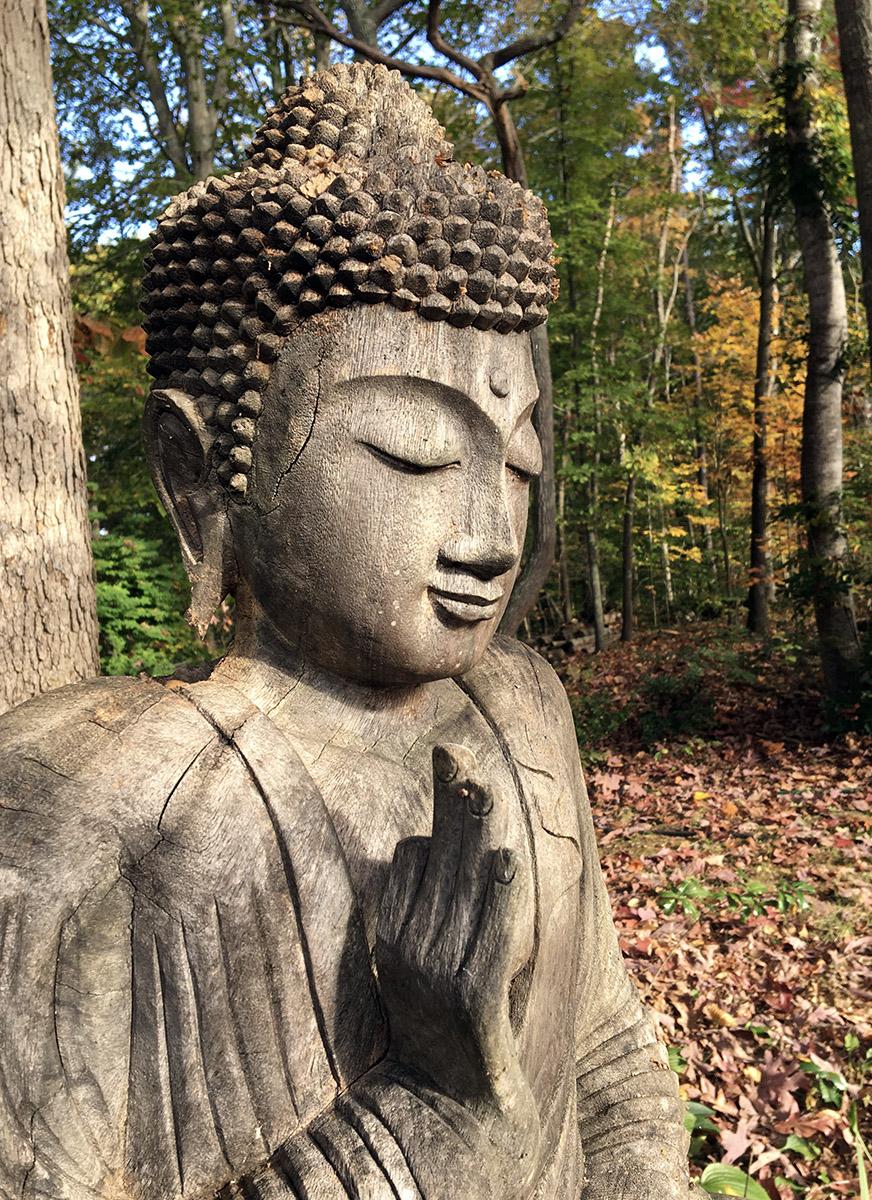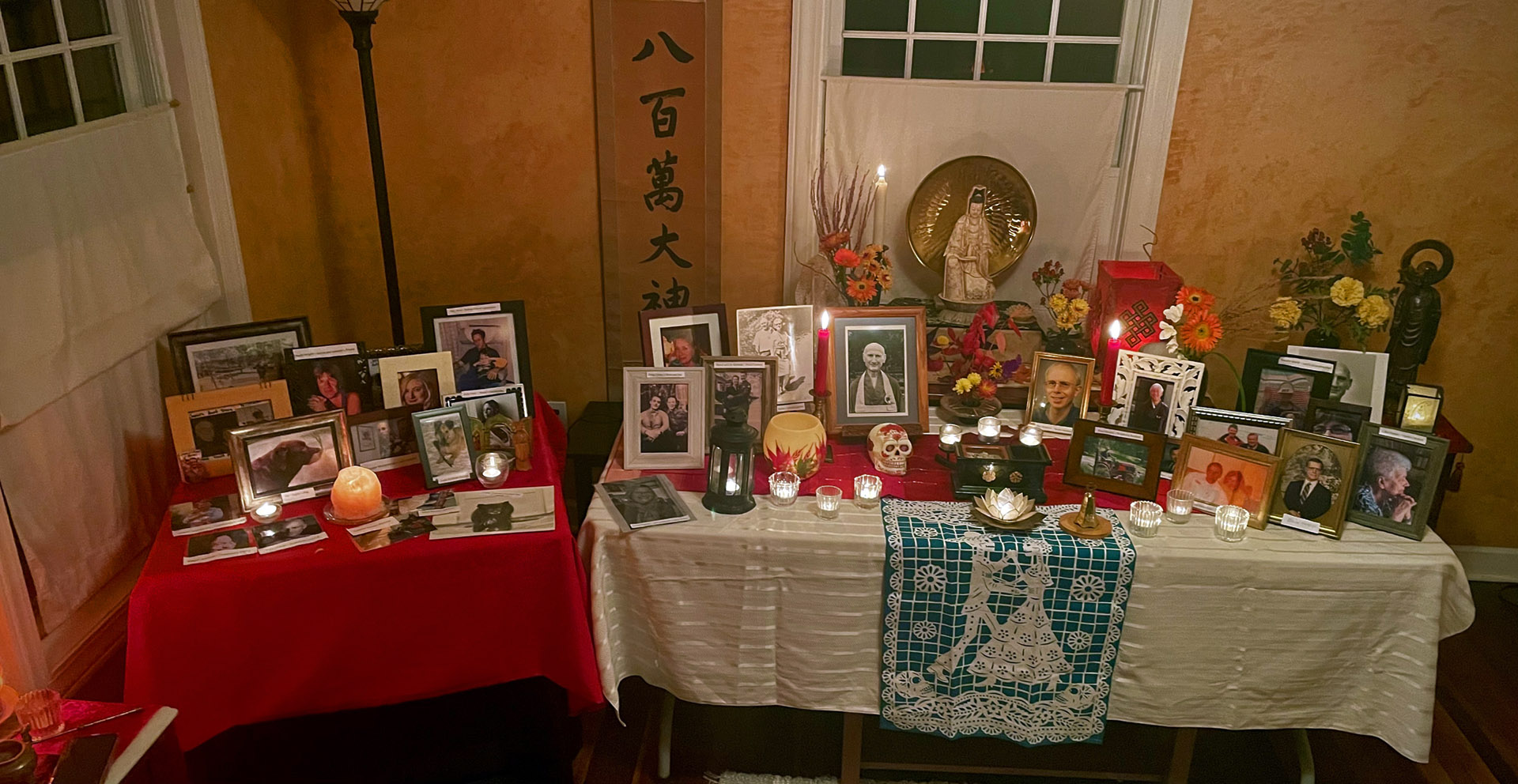November: A time of inward-turning as the darkness increases–when the great teaching of Death and Dying vividly plays itself out all around us. Leaves flying and falling and covering the ground; dark, bare branches appearing; the gorgeous colors of early autumn now shifting into a more somber palette of brown and grey and olive green — it’s all so obvious. And no more brightly colored wildflowers for altar arrangements. Brings to mind those words of Dogen:
Flowers fall despite our love for them,
Weeds spring up despite our aversion.
This is a deeper, quieter time when the membrane between the living and the dead seems thinner, more permeable. No wonder that at this time of year people all over the world engage in ceremonies and celebrations to remember and honor family and friends who have died. Here at Windhorse we recently held a Memorial zazenkai, a day of silent practice—online or in-person, with an invitation to submit photos of loved ones who have passed, both humans and animals, to place on our memorial altar table.
So deeply affecting: to stand in the Kannon Room gazing at all these candlelit photos of sangha members’ friends and family, to join our voices in chanting the Kannon Sutra while slowly circumambulating through the center, to stop before this memorial altar to take it all in before making an offering of powdered incense, ringing the little bell, bowing, and moving on.
There’s a Danish proverb: The falling of a leaf is a whisper to the living. The death of a family member, a friend, a Dharma brother or sister, a beloved dog or cat, is more than a whisper – it’s a trumpet call to each of us to make the most of this precious lifetime to resolve the Great Matter of Birth and Death.
Allen Ginsberg once said that the major revelation of his life was, “I am alive in a body that is going to die.” Yet, most of us move along in our lives as though we were immortal. In Carlos Castaneda’s Journey to Ixtlan, the Yacqui shaman and sorcerer Don Juan says to Castaneda, “That is why you are so moody and not fully alive, because you forget you are to die; you live as if you were going to live forever.”
For Don Juan, death was an ally, inspiring us to make each moment more alive. “The thing to do when you’re impatient,” he proceeded, “is to turn to your left and ask advice from your death. An immense amount of pettiness is dropped if your death makes a gesture to you, or if you catch a glimpse of it, or if you just have the feeling that your companion is there watching you.”
Facing death is simply facing reality – the reality that death is the only guarantee we have in life, and we never know when or how it will come. Reflecting on death isn’t some ‘morbid’ thing; it’s healthy and vital and gives power and force and focus to our life and practice. If we knew for certain that tomorrow would not come, how would we spend our time today?
Aren’t we all guilty of the sloppy and comforting assumption, held on a very deep level of consciousness, that life will go on and on? As the American writer Henry Miller put it, “Life, as it is called, is for most of us one long postponement.”
The need for this life-giving death-awareness is found in almost every spiritual tradition. It’s also in our deepest common sense: facing up to our mortality opens us to a richer appreciation of life. So inevitably, when we speak of death we have to speak of life and vice versa. All one indissoluble wholeness! And in fact birth and death are occurring at every moment—with every inbreath and outbreath—constantly taking in life, then letting it go. . .
If we run from death’s terror and mystery, we live with perpetual underlying anxiety. As Martin Heidegger wrote, “Anxiety is there; it is only sleeping. Its breath quivers perpetually through man’s being.” Inevitably the repressed fear and numbness harden into armor, choking off our ability to live freely and deeply—in other words, to truly live. As an African blessing goes: “When Death comes, may he find you alive.”
Zen doesn’t offer soothing words of consolation or explanations about death. Instead, it urges us to directly face the powerful mystery of our own life and death, and to use that awareness to sharpen our appreciation for this precious human existence, to inspire us to “arouse the mind that seeks the Way,” and to see through, once and for all, the profound delusion of being a separate, limited ego-entity subject to birth and death.
This season of autumn heading into the Winter Solstice is a time of depth and richness and silent power—a time when the sap returns to the roots. A soulful time, as nights stretch out and the days grow chilly—a fine time for this inward-turning practice. Zazen moves us beyond the surface consciousness of restless agitation and anxiety, back to the core of our being. It gives us a time-honored way to return to our own living root—to our own True Home where “death” and “birth” simply do not apply.


